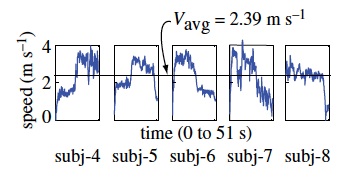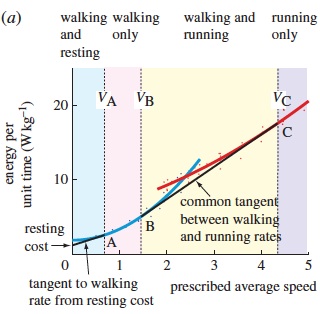Overground Gait transitions:
Optimality of Walk-Run-Rest mixtures
Human experiments and Mathematical Theory
This webpage supports the following article about people walking sideways. If you need more information about this article that is not available on this page, please contact Manoj Srinivasan.
Article
Title: Walking, running, and resting under time, distance, and average speed constraints: optimality of walk–run–rest mixtures.Journal and year: Journal of Royal Society Interface, 10, 20120980, 2013.
Authors: Leroy L. Long and Manoj
Srinivasan
Full article: (PDF with supplementary information)
Abstract:
On a treadmill, humans switch from walking to running beyond a
characteristic
transition speed. Here, we study human choice between walking
and
running in a more ecological (non-treadmill) setting. We asked
subjects to
travel a given distance overground in a given allowed time
duration.
During this task, the subjects carried, and could look at, a
stopwatch that
counted down to zero. As expected, if the total time available
were large,
humans walk the whole distance. If the time available were
small, humans
mostly run. For an intermediate total time, humans often use a
mixture of
walking at a slow speed and running at a higher speed. With
analytical
and computational optimization, we show that using a walk–run
mixture
at intermediate speeds and a walk–rest mixture at the lowest
average
speeds is predicted by metabolic energy minimization, even with
costs for
transients—a consequence of non-convex energy curves. Thus,
sometimes,
steady locomotion may not be energy optimal, and not preferred,
even in
the absence of fatigue. Assuming similar non-convex energy
curves, we conjecture
that similar walk–run mixtures may be energetically beneficial
to
children following a parent and animals on long leashes. Humans
and
other animals might also benefit energetically from alternating
between
moving forward and standing still on a slow and sufficiently
long treadmill.
Major results
For intermediate average speeds (just over 2 m/s), humans use a mixture of walking and running, as shown in the following GPS speed measurements for five subjects.


Other Implications, predictions, and conjectures
1. A child following her parent at 1.4 m/s may save energy by a walk-run mixture.
2. Dogs on a long leash at average 1.3 m/s may save energy by walk-trot mixtures
3. Animals and humans on long slow treadmills may stand/coast backward and then scoot forward (walk or run).
4. Average Marathoners (2.3 m/s, 5 hour marathon, 10 minute mile) will save energy by a walk-run mixture.
5. Soccer players (2.1 m/s), and persistence hunters (1.75 m/s) have average speeds close to when a walk-run mixture is optima. While they do have other constraints, do they mix walking and running?
6. If you are given a choice between walk and then rest by sitting versus walk and then rest by lying down, theory predicts that you should walk faster in the second situation!
7. Theory suggests greatest behavioral variability near the gait transition, as observed in experiment.
The appendix includes a number of other mathematical optimization calculations applied to gait transitions on a long treadmill, etc.Press
ScienceNOW
(Science Magazine's website): Are
we built to be lazy? By Lizzie Wade.
Wired
Magazine. By Lizzie Wade (same as above).
Runner's
World. By Scott Douglas.
National
Geographic. Why
We Walk … and Run … And Walk Again to Get Where We're Going.
By Marc Silver.
Prevention
Magazine. By Kiera Aaron.
SlashDot.
KennisLink
(Dutch).
OSU
News Release.
PhysOrg. by Pam Gorder.
EurekaAlert.
Hindustan
Times.
Spanish.
Chinese.
Italian.
Korean.
(Translations and Adaptations of above)
Funding
This work was supported by the Ohio State University.